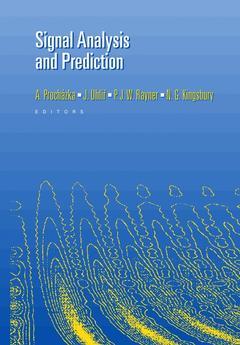Signal Analysis and Prediction, 1998 Applied and Numerical Harmonic Analysis Series
Langue : Anglais
Auteurs : Prochazka Ales, Kingsbury N.G., Payner P.J.W., Uhlir J.

Methods of signal analysis represent a broad research topic with applications in many disciplines, including engineering, technology, biomedicine, seismography, eco nometrics, and many others based upon the processing of observed variables. Even though these applications are widely different, the mathematical background be hind them is similar and includes the use of the discrete Fourier transform and z-transform for signal analysis, and both linear and non-linear methods for signal identification, modelling, prediction, segmentation, and classification. These meth ods are in many cases closely related to optimization problems, statistical methods, and artificial neural networks. This book incorporates a collection of research papers based upon selected contri butions presented at the First European Conference on Signal Analysis and Predic tion (ECSAP-97) in Prague, Czech Republic, held June 24-27, 1997 at the Strahov Monastery. Even though the Conference was intended as a European Conference, at first initiated by the European Association for Signal Processing (EURASIP), it was very gratifying that it also drew significant support from other important scientific societies, including the lEE, Signal Processing Society of IEEE, and the Acoustical Society of America. The organizing committee was pleased that the re sponse from the academic community to participate at this Conference was very large; 128 summaries written by 242 authors from 36 countries were received. In addition, the Conference qualified under the Continuing Professional Development Scheme to provide PD units for participants and contributors.
Signal Analysis.- Time-Frequency and Time-Scale Signal Analysis by Harmonic Wavelets.- Wavelet Transforms in Image Processing.- General Sub-Band DCT: Fast Approximate Adaptive Algorithm.- Higher-Order Statistics in Signal Processing.- Constrained Optimization Using Geometric Algebra and its Application to Signal Analysis.- Processing of Non-Stationary Vibrations Using the Affine Wigner Distribution.- Coarsely Quantized Spectral Estimation of Radio Astronomic Sources in Highly Corruptive Environments.- Wavelet Transform Implementation for Star-Shaped Modelling.- Signal Identification and Modelling.- The Bayesian Approach to Signal Modelling.- Regularized Signal Identification Using Bayesian Techniques.- System Identification.- ARMAX Model Identification with Unknown Process Order and Time-Varying Parameters.- Using Kautz Models in Model Reduction.- Condition Monitoring Using Periodic Time-Varying AR Models.- Rayleigh Quotient Iteration for a Total Least Squares Filter in Robot Navigation.- Wavelet Use for Noise Rejection and Signal Modelling.- Self-Reference Joint Echo Cancellation and Blind Equalization in High Bit-Rate Digital Subscriber Loops.- Signal Prediction.- Predictability: An Information-Theoretic Perspective.- Self-Adaptive Evolution Strategies for the Adaptation of Non-Linear Predictors in Time Series Analysis.- Non-Linear Dynamic Modelling with Neural Networks.- Non-Linear Adaptive Prediction of Speech with a Pipelined Recurrent Neural Network and Advanced Learning Algorithms.- Neural and Fuzzy Logic Video Rate Prediction for MPEG Buffer Control.- A Motion Compensation Algorithm Based on Non-Linear Geometric Transformations and Quadtree Decomposition.- Smoothing Techniques for Prediction of Non-Linear Time Series.- Non-Parametric Forecasting Techniques for Mixing Chaotic Time Series.- Speech and Biomedical Signal Processing.- Signal Analysis and Modelling for Speech Processing.- Modulation Spectrum in Speech Processing.- Detection and Discrimination of Double Talk and Echo Path Changes in a Telephone Channel.- A CELP-Based Speech-Model Process.- Vector-Predictive Speech Coding with Quantization Noise Modelling.- Modelling Signal Dynamics in Voiced Speech Coding.- Experimental Study of Speech Recognition in Noisy Environments.- Non-Linear Parametric Modelling by Means of Self-Exciting Threshold Autoregressive Models.- Lyapunov Exponents of Simulated and Measured Quasi-Periodic Flows.- Rank Order Based Decomposition and Classification of Heart Rate Signals.
Ouvrage de 502 p.
17.8x25.4 cm
Date de parution : 06-2013
Ouvrage de 502 p.
17.8x25.4 cm
Disponible chez l'éditeur (délai d'approvisionnement : 15 jours).
Prix indicatif 128,17 €
Ajouter au panierThème de Signal Analysis and Prediction :
© 2024 LAVOISIER S.A.S.



